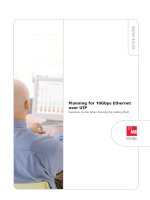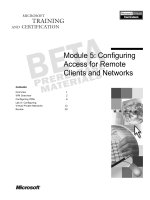Tài liệu Create New Event Monitor For Locking ppt
Bạn đang xem bản rút gọn của tài liệu. Xem và tải ngay bản đầy đủ của tài liệu tại đây (429.95 KB, 14 trang )
Create New Event Monitor For Locking
Create lock event monitor and disable old monitor
• Deactivate & Drop DB2DETAILDEADLOCK event monitor
SET EVENT MONITOR DB2DETAILDEADLOCK state 0
DROP EVENT MONITOR DB2DETAILDEADLOCK
• Create event monitor, direct output to table/tablespace
CREATE EVENT MONITOR lockevmon FOR LOCKING - ALL LOCKING types
WRITE TO UNFORMATTED EVENT TABLE - NEW TABLE TYPE must format
(TABLE MYLOCKS IN TS32K PCTDEACTIVATE 75) - EVM deactivates at 75%
Create New Event Monitor For Locking – Cont.
• Format Unformatted Event Table
• db2evmonfmt
• java tool found in samples\java\jdbc (must compile to class file)
• java db2evmonfmt -d
db_name -ue table_name -ftext -u user_id -p
password
• XML or Formatted text output
• EVMON_FORMAT_UE_TO_XML (table function)
• Call to format Unformatted Event Table into XML document
• EVMON_FORMAT_UE_TO_TABLES (procedure)
• Call to format Unformatted Event Table into regular Table
• Calls
evmon_format_ue_to_xml
table function
• Default tables (defined in /sqllib/misc/DB2EvmonLocking.xsd)
• SYSIBMADM.LOCK_EVENT
• SYSIBMADM.LOCK_EVENT_PARTICIPANTS
• SYSIBMADM.LOCK_PARTICIPANT_ACTIVITIES
db2pd – The DB2 Problem Determination Tool
• db2pd
• Diagnose lockwaits
• Map application to dynamic SQL statement
• Monitor Memory usage
• Map application usage to tablespace
• Monitor log usage
• Includes WLM metrics
• Assess Index usage
• And more…
db2pd example: Mysterious slowdown every afternoon
• Users report an overall slowdown every afternoon at 1pm,
claiming nothing has changed
• Performing runstats does not solve the problem, eliminating
out of date statistics as a culprit
• Checked different database indicators such as buffer pool hit
ratios, lock waits etc. No bottlenecks found
• “vmstat” shows high user cpu and first clue in the mystery:
procs memory swap io -system cpu
r b swpd free buff cache si so bi bo in cs us sy id wa st
2 0 520800 60916 3800 438032 32 132 393 183 280 451 53 8 33 6 0
1 0 520800 60636 3808 438032 0 0 0 48 259 376 57 4 37 2 0
3 0 520800 60652 3824 438032 0 0 0 8 263 393 54 8 34 4 0
1 0 520800 60776 3832 438032 0 0 0 26 258 371 60 1 39 0 0
Mysterious slowdown every afternoon
• User cpu is high which indicates that it is due to some
activity in the application space (DB2) and not in the
operating system
• Use “db2pd –edus” to see cpu usage by each thread:
EDU ID TID Kernel TID EDU Name USR (s) SYS (s)
………………….
21 2946493344 10227 db2agent (DS2) 2.200000 0.900000
0.000000 0.000000
20
2947541920
10226
d
b2lfr (DS2)
19
2948590496
10225
d
b2loggw (DS2)
1.700000
0.600000
18
2949639072
10224
d
b2loggr (DS2)
2.170000
1.680000
17
2950687648
10214
db2agent (DS2)
29.310000
4.600000
16
2951736224
10201
db2
r
esync
0.000000
0.000000
15
2952784800
10200
db2tc
p
cm
0.310000
0.450000
EDU id 17 stands out because it is using significantly more user cpu
Please note: These values are cumulative over the life of EDU so it may be
important to know the relative rate change of the CPU usage
Mysterious slowdown every afternoon
• Use “db2pd –db ds2 –applications” to find out the
application being served by EDU ID 17:
Address App- [nod-index] Num- Coor- Status L-Anch- L-Stmt- Appid
Handl Agents EDUID ID UID
0x20A55FD0
12 [000-00012] 1
30
ConnectCompleted
0
0 *LOCAL.DB2.091015124129
0x20A50060
11
[000
-
00011]
1
29
Connect
C
ompleted
0
0
*LO
C
AL.
D
B2.091015124128
0x20A45FD0
10
[
000
-
00010]
1
28
ConnectCompleted
0
0
*LOCAL.
D
B2.091015124127
0x20A40060
9
[000
-
00009]
1
27
ConnectCompleted
0
0
*LO
C
AL.
D
B2.091015124126
0x20A06C00
8
[
000
-
00008]
1
26
ConnectCompleted
0
0
*LOCAL.
D
B2.091015124125
0x20A00060
7
[000
-
00007]
3
17
Performing
L
oad
937
1
*LO
C
AL.johnh.091015130001
** Some columns are not shown to fit the output
•Application handle 7 is being serviced by EDU id 17.
•Status filed shows that it is performing a LOAD which explains the problem.
•Novice user johnh has loads scheduled to run at 1pm.
•Load is a resource intensive operation and running it during production hours
causes everything else to run slower!
DB2 Performance Monitoring Essentials
A
A
g
g
e
e
n
n
d
d
a
a
• Introduction
• Monitoring Interfaces available with DB2
• Essential Monitoring Targets
• Monitoring tools
Essential Monitoring Targets
• Track key performance indicators
• Practical approach, too many = diminished returns
• Key DB2 monitoring elements as indicators
• Stand Alone Elements
• Calculate Ratios
• DB2 monitoring elements can be captured from:
• Snapshot Monitoring
• Switch based
• Some CPU overhead (1-10%)
• Easy to reset counters
• New Monitor Table functions and Views via SQL
• SQL based, easy to tabularize
• Monitoring elements queried from memory, lower overhead than
Snapshot based monitoring
Essential Monitoring Targets – Database Level
• Key areas
• TOTAL TRANSACTIONS
• BUFFER POOL HIT RATIOS (DATA, INDEX, TEMP)
• READS AND READ EFFICIENCIES
• SORTING
• LOCKS
• PAGE CLEANING
• PACKAGE CACHE CAPACITY
• TRANSACTION LOGS
• Save data to tables
• Aggregate, differentiate, interpolate, extrapolate Æ modulate
•
Look for trends
• Avoid catastrophes
• Easier to fix before broken
Essential Monitoring Targets – Total Transactions
• The number of transactions executed by applications
• Use snapshot monitoring to retrieve
• Database Level, Application Level
• COMMIT_SQL_STMTS + ROLLBACK_SQL_STMTS
• Comparable WLM elements (v9.7 fp1)
• TOTAL_APP_COMMITS + TOTAL_APP_ROLLBACKS
• Useful for creating key ratios like reads/commit
• Adds element of “relativity” to monitoring
Essential Monitoring Targets – BP Hit Ratio
• Buffer pool hit ratios
• With MON_BP_UTILIZATION monitor view
Hit Ratio for All Data,Index, and XDA for each Bufferpool
SELECT
SUBSTR(bp_name ,1,30) as BPNAME,
data_hit_ratio_percent as DATA_HR,
index_hit_ratio_percent as INDEX_HR
,
xda_hit_ratio_percent as XDA_HR
FROM
SYSIBMADM.MON_BP_UTILIZATION
Essential Monitoring Targets – BP Hit Ratio
• Buffer pool hit ratios, measured separately for data, index,
and temporary data
• With BP_HITRATIO administrative view
Example: Returns bufferpool hit ratios, including total hit ratio, data hit ratio, XDA hit ratio
and index hit ratio, for all bufferpools and all database partitions in the currently
connected database.
SELECT SUBSTR(db_name,1,8) AS DB_NAME, SUBSTR(bp_name,1,14) AS BP_NAME,
total_hit_ratio_percent as TOTAL_HR, data_hit_ratio_percent as DATA_HR,
Index_hit_ratio_percent as INDEX_HR, xda_hit_ratio_percent as XDA_HR,
dbpartitionnum as DBPARTNUM
FROM
SYSIBMADM.BP_HITRATIO
ORDER BY dbpartitionnum
• SNAP_GET_BP_V95() administrative table function
• Use to aggregate results from all partitions or report on single partition
• GET SNAPSHOT FOR DATABASE
• Use from command line
Essential Monitoring Targets – I/O efficiency
• The number of Rows Read per Transaction
• With SYSIBMADM.SNAPDB
Is that a
lot?
SELECT VARCHAR(db_name,10),
OLTP
< 10 Excellent
10-20 Very Good
20-40 Fair
> 50 Tune
CASE WHEN (commit_sql_stmts + rollback_sql_stmts) > 0
THEN DEC(((rows_read) / commit_sql_stmts + rollback_sql_stmts),13,2)
ELSE NULL
END AS READS_PER_TRANSACTION,
rows_read as ROWS_READ,
commit_sql_stmts + rollback_sql_stmts as TOTAL_TRX,
db_conn_time as FIRSTDB_CONN,
last_reset as LAST_RESET
FROM
SYSIBMADM.SNAPDB;









